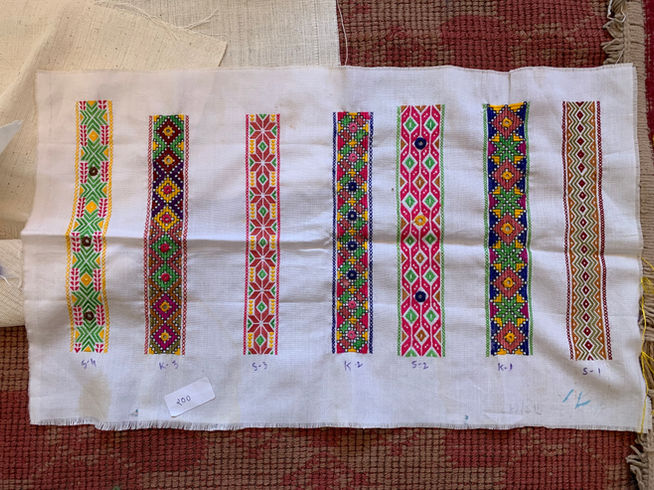Soof (or Suf): A typeface that celebrates the intricate beauty of the handmade
Region: Mundra, Kutch, Gujarat, India
The Meghawaad Maaru community is originally from Tharparkar in Sindh, Pakistan and came to India as refugees during the 1971 war between India and Pakistan. The women of this community practice two styles of embroidery— soof and khaarek. Soof is a fine, delicate embroidery with geometrical motifs and is used to create articles like garments, bedspreads, torans (textile banners used at entranceways of homes), etc. Soof embroidery is light, so even a heavily embroidered sari is easy to handle and wear.
They traditionally embroider small products such as baagchi (envelope bags), theli (multi-purpose bags) and batwa (small bags). The embroidery features an abundance of floral and leaf motifs. Animal, bird and figurative motifs seldom made an appearance. The only exception is the peacock motif for which the craftswomen had a particular fondness.
The building blocks of the embroidery area lath, soof (triangles) and leher (wave). Craftswomen play with these forms to create a huge variety of simple as well as complex geometric motifs.There is no outline or drawing done on the fabric to guide the craftswoman. Instead, the design is mentally conceptualised and calculated according two the design, the cloth size and count and rendered onto it by counting the warp and weft threads of the fabric.
The designs are formed with tessellated triangles called soof (suf). It is a counted thread embroidery with no outlines and drawings done on a white fabric to guide the craftswoman. The embroidery, done on the reverse side, is created by filling in areas using a satin stitch. When turned over, the front displays an embroidery that is so fine and precise that it is mistaken for machine embroidery.
Soof requires fabric that has a basket weave—the warp and weft have to be the same count. Patterns are created by counting the warp and weft threads that are used as the base grid. The embroidery is rendered on a horizontal and vertical grid. However, the most daring innovation was creating complex compositions on diagonal grids. This is why when making letters, the diagonals such as the K, X, R etc., are the most complex and difficult to make.
The indicators of technical excellence in Soof embroidery are:
● Varied and complex compositions.
● Thin and sturdy stitches rendered so tightly that the maximum area of the mirrors in exposed.● The base fabric underneath the embroidery does not show through.
Soof Workshop overview
Pre-Workshop preparatory work at the studio
Before the workshop in Kutch the team, worked with sample sketches, hand-drawn and digital to understand the forms and motifs of soof embroidery. We worked with an array of letter design that we thought could be embroidered by the artisans. Our goal to create letters from before hand was to explore the relation between the latin letters and the motifs to incorporate the essence of the embroidery as well as make the letters legible. The challenge we had to surpass while working was the diagonal letters like K and X as soof is always embroidered on a horizontal and vertical grid.
Typecraft Design Methodology Workshop
Project conducted at Shrujan, Kutch, who also provided us with the group of craftswomen and with technical support to enable us to understand and work with the embroideries.
Our Theory of Change is to inspire and excite craftspeople about the possibilities of their own craft through our Typecraft Design Methodology Workshops. We always mindful of the fact that while we might be transferring design knowledge to craftspeople they are transferring us knowledge of their craft to us as well.
An important part of The Typecraft Initiative Mandate is to promote value addition of the craftspeople we work with by imparting fundamental design methodologies to help artisans to become authors of their own work, so that they can make innovative products relevant to the demands of today's fickle customer.
We started the workshop by giving the craftswomen a design exercise in which they would use paper cut-out into the various shapes of their embroidery to make letters. Interestingly, this is the same methodology (but done in reverse) that we use in design schools to teach students to make fonts by understanding the lexicon of a particular craft.
Why letters?
Letters are alien to the everyday world of the women who embroider various plant and animal motifs. Giving them something our of context challenges them to really understand what sorts of new forms their embroideries can take. The women we worked with told us that they are usually given the designs to make and so they end up making but not applying their minds to think of new possibilities.
Breadth rather than Depth
Our workshops are meant to explore different ways a letter can be made, rather than to use one way and render all letters. Working this way ensures no stone is unturned in terms of the various types of embroideries and techniques explored. For instance, the "R" by Paani ben has been done in a "traditional" technique where the embroidered thread is hidden within the cloth. Here Paani ben also explores the use of gaps in the letterform, which we term as a "soof-serif" as they look like a serifed letter. We also explored the embroideries in terms of the types of base cloth — matka silk for the larger designs and the organic and indigenous cotton, kala cotton for the smaller designs.
Download Presentation
Credits
Craftspersons - Paniben Prabhubhai Rathod, Rathod Hetal Prabhubhai, Charu Lata ben, Amisha ben, Manisha ben, Varsha ben, Ramila ben and Gita ben
Designer and Craft Co-ordinator - Ishan Khosla, Roshel Chawla, Kajama Chakma
Type Development - Andreu Balius
Volunteers– Fahila Mansuri, Maitri Soni, Pankti Patel, Riya Bansal, Shruti Jain
Project Supported by - Synergy Consulting Inc. and Mon Ami Foundation
Technical Support - Shrujan
























